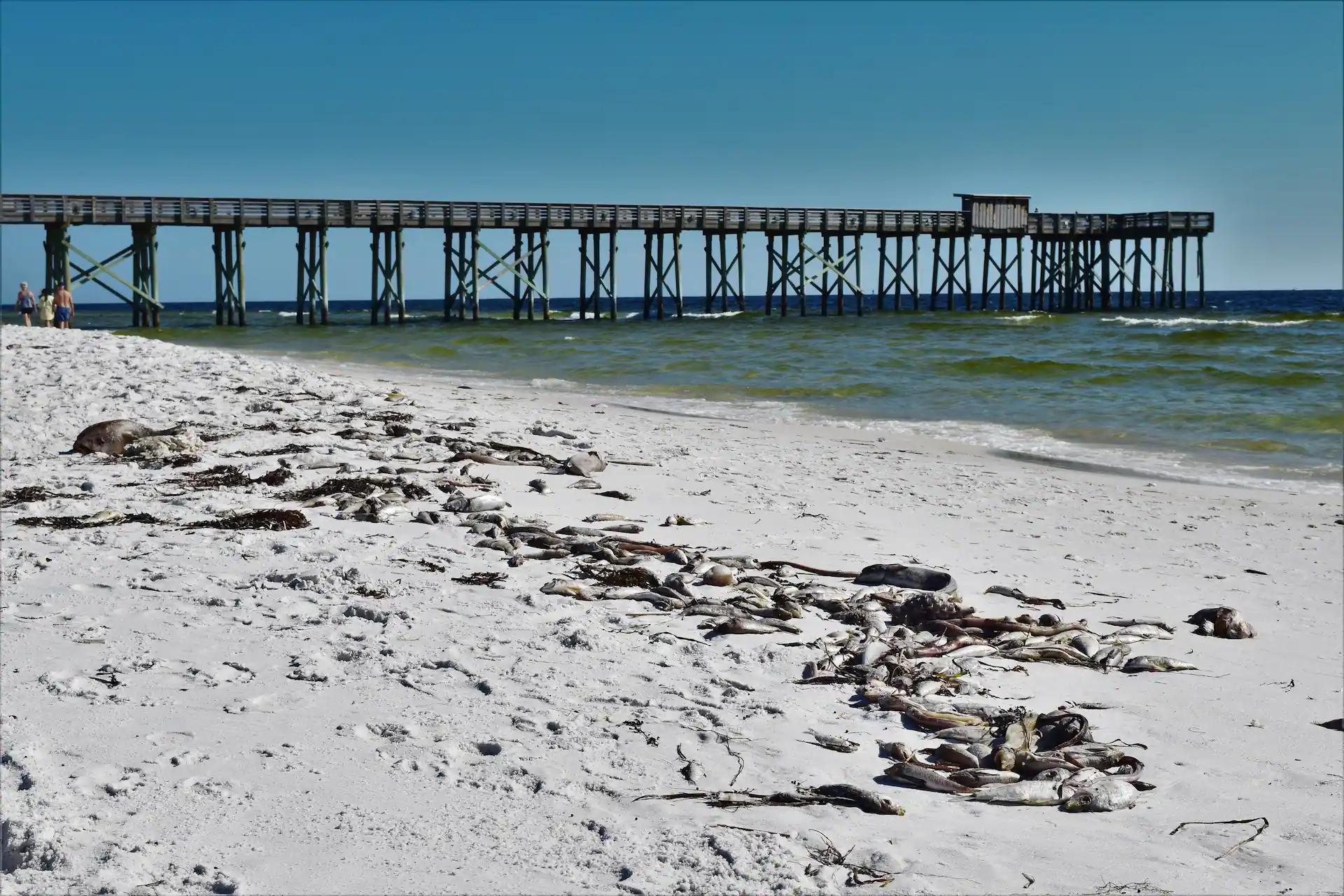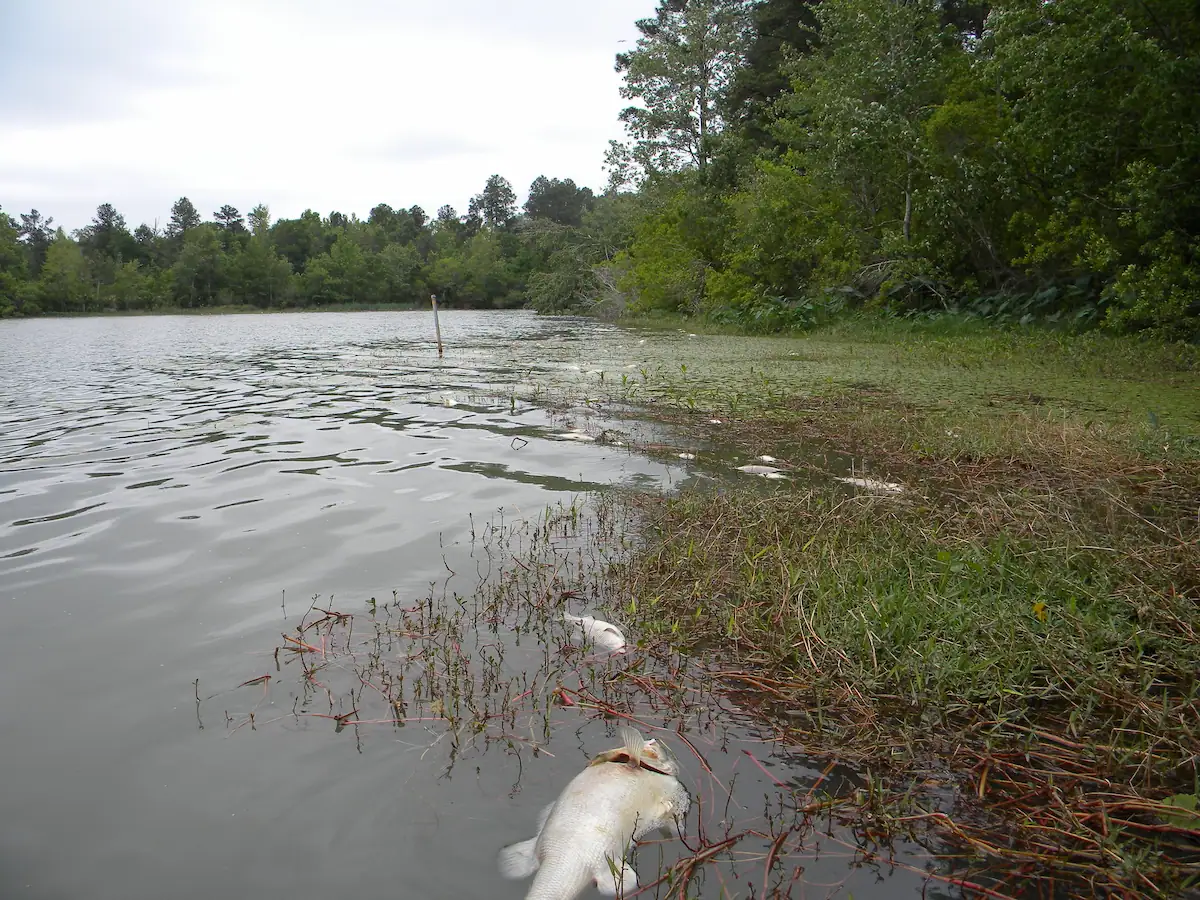Five Things You Didn’t Know About Red Tide
Red tides are harming our waters and killing ocean life

Imagine lounging on a beach chair, an umbrella perched perfectly above as you look out onto the beautiful ocean waves, each crash like music to your ears. You take a deep breath and feel the cool breeze fill your lungs. Life is good.
Now imagine that cool breeze smells a bit off, actually really off, and you see some discolored water and dead fish in the distance. Suddenly this beach day is not so perfect.
Get Ocean Updates in Your Inbox
Sign up with your email and never miss an update.
What’s going on? These unfortunate situations result when algae, plant-like organisms, grow out of control and cause a red tide event.
Red tides, or more specifically proliferation of harmful algal blooms or HABs as known by scientists, are formed when an extremely high amount of microscopic algae grow uncontrollably and cause negative effects on marine life, people and ecosystems that depend on healthy water. These events occur all over the world, but they are especially persistent in Florida’s waters.
Jump in for more as we explore five things you probably didn’t know about red tide events and how red tide affects our most treasured beaches.
What Causes Red Tide?
Red tide events tend to be caused by specific kinds of phytoplankton that contain a reddish pigment called peridinin. These patches of red ocean are typically caused by dinoflagellates, which are microscopic single-celled plankton that contain this pigment. It is interesting to note, however, that not all red tides are red; some don’t have any discernible color at all. Specifically in Florida, the dinoflagellates that typically cause a red tide event are called Karenia brevis or K. brevis. Also contributing to these harmful events are human-made pollutants that wash into our ocean and supercharge low levels of naturally occurring algae. A cause of this pollution comes from nitrogen runoff found in the fertilizers used in our yards or that leaches from failing septic tanks into local waterways.
Are All Algal Blooms Bad?
Not all algal blooms are harmful. In fact, most algae are good for the ocean ecosystem as they are at the base of the food web, feeding organisms from tiny animals called zooplankton to small fish that, in turn, support larger animals such as sharks, tunas and sea lions. Thus, these tiny organisms themselves are vital to the ocean food web. However, there is a tipping point when algal blooms can become harmful. This occurs when the blooms produce toxins that are released into the air and can harm humans visiting the beach.
Does Red Tide Negatively Affect Marine Life?
Undoubtedly, red tide events are also capable of causing immense harm to sea life, from fish to the sea birds that eat them. Even algal blooms that don’t produce harmful toxins can negatively impact marine ecosystems and wildlife. As blooms of non-toxic algae decay, the oxygen levels in sea waters drop, forcing local sea life to find safer waters or die due to asphyxiation. The resulting combination of dead fish and rotting algae hosts an abundance of bacteria that leaves behind an undeniable smell you can’t miss. Decomposing fish also release nutrients that can fuel red tide, killing even more fish and worsening red tides still further. In addition, algal blooms reduce the sunlight available to seagrasses, leading to losses of this essential habitat for fish and manatees. So many of our sea friends, like pelicans and manatees, are heavily impacted by these harmful algal blooms. Sadly, the first signs of a harmful red tide event tend to be evidence of sick marine life like them.

Does Red Tide Harm Human Health?
Unfortunately for us, humans are not immune to the harmful impacts of a red tide event. In Florida, the K.brevisdinoflagellate that causes red tide produces brevetoxins which are odorless and tasteless molecules that can damage the central nervous system of marine life and humans. Many beaches where these events tend to occur post signs warning visitors of potential symptoms, including skin or eye irritation and coughing or sneezing. Going into the affected water or just breathing in the foul odor of red tide can cause these events, harming people who don’t even step foot into the ocean. Although these are moderately mild symptoms, further harm can emerge when contaminated fish or shellfish are harvested and consumed. Consuming affected fish can not only make people sick but also in rare cases can be fatal.
Can We Make a Difference?
If we humans lessen our impacts on our ocean and other waterways, red tide events will not go away but can become less harmful and more manageable. This improvement to ocean waters can start by thinking twice before using certain fertilizers and treating our waterways more carefully. In addition, we can call on our elected officials to enact legislation that tackles these harmful algal blooms and other water quality issues. These activities are a priority for Ocean Conservancy, and we appreciate the support of your voice and action as an advocate for the ocean. In addition, you can help by calling on members of Congress for more funding for research currently underway at NOAA to help prepare for red tide impacts.
The time is now to work towards better water quality for our ocean and kick red tide to the curb. Ready to take action for our ocean against red tide? Check out our action center where you can advocate for more funding for NOAA as well as protection for manatees.